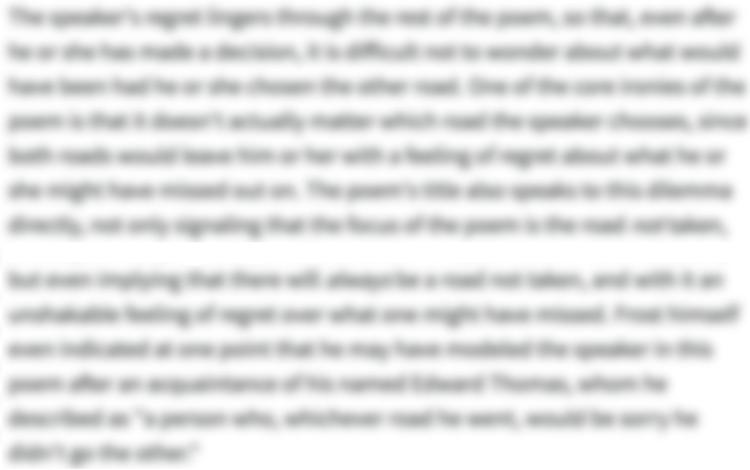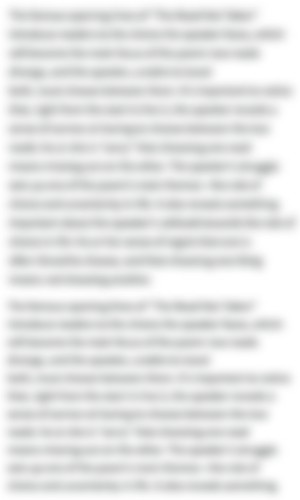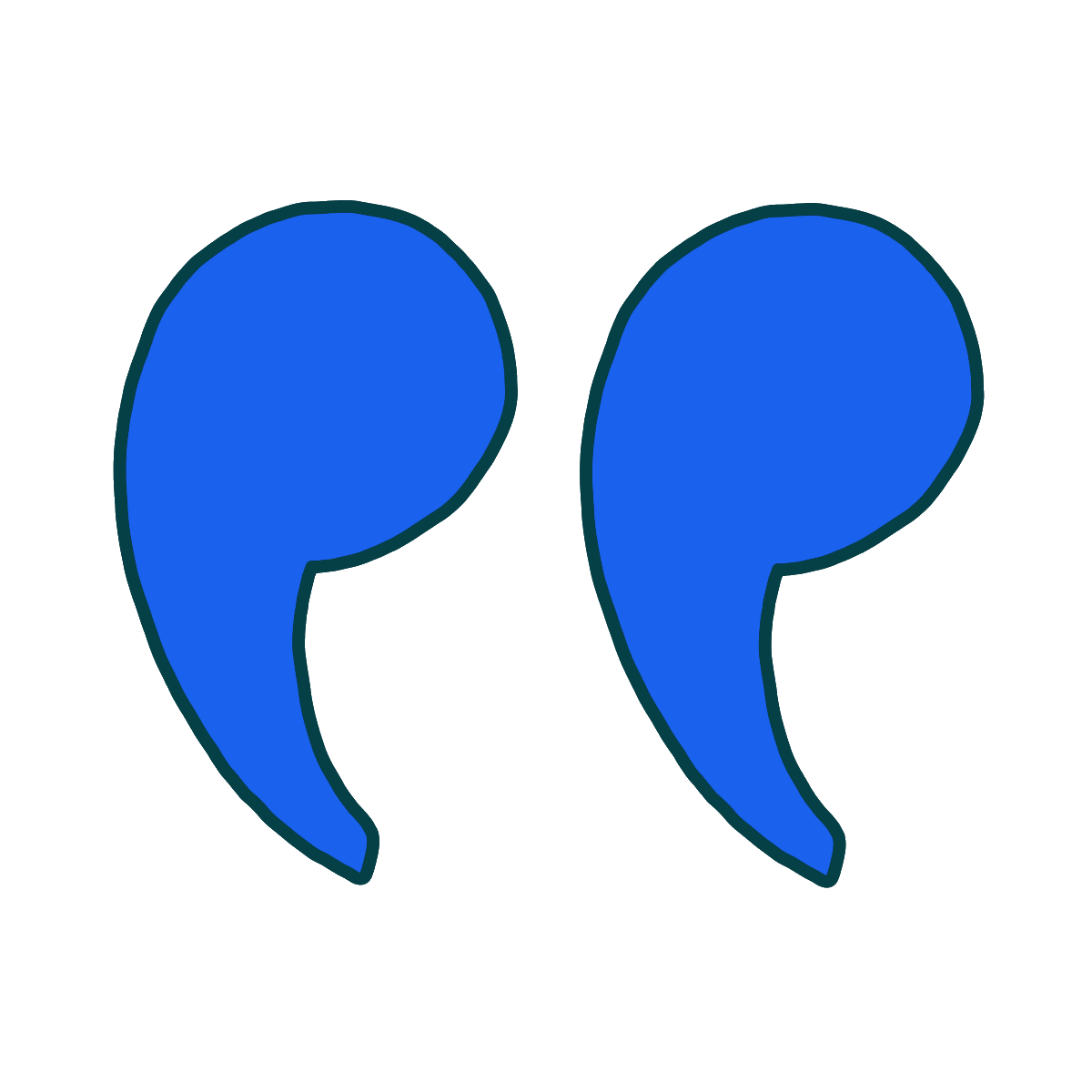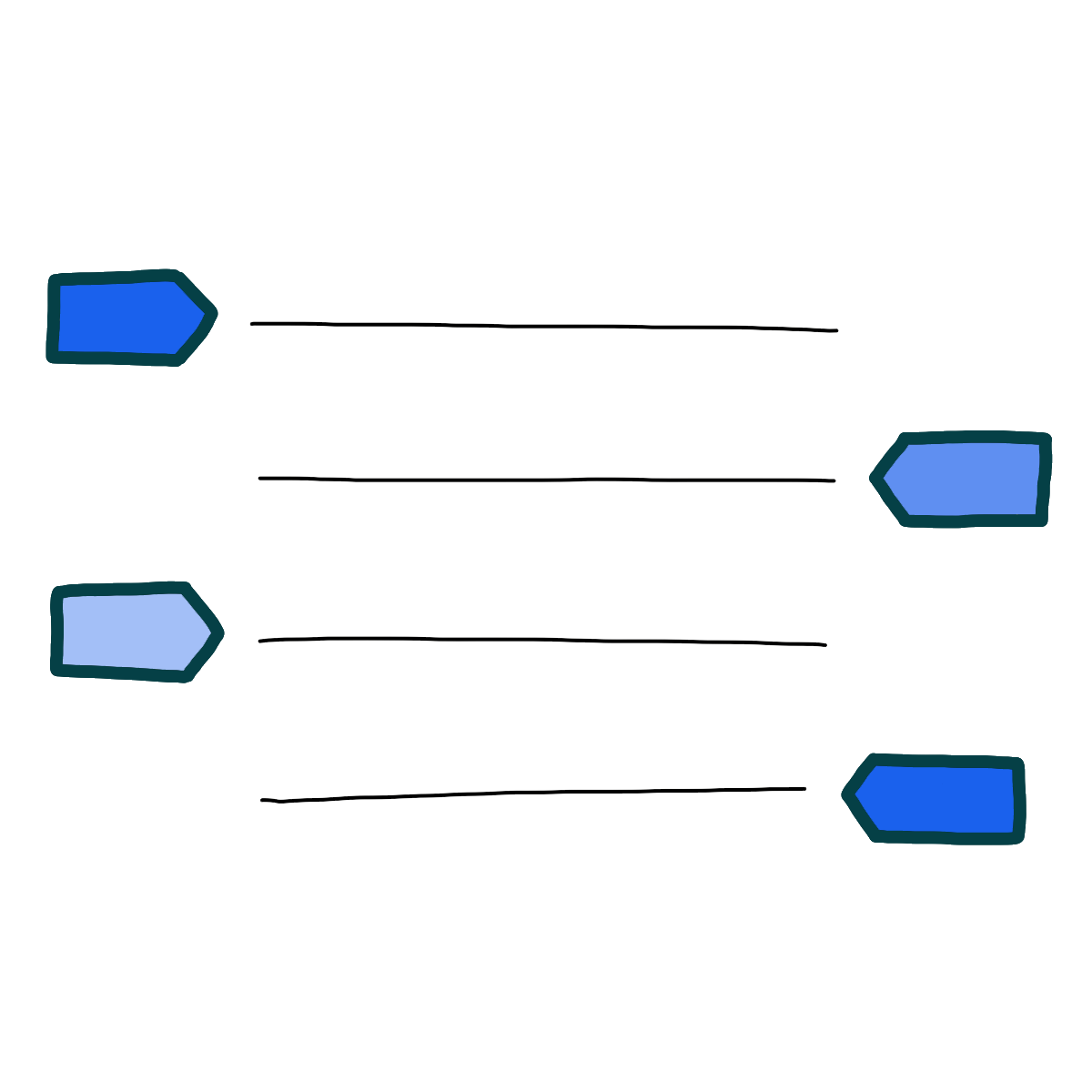-
“Wind” Introduction
-
The British poet Ted Hughes published "Wind" in his 1957 collection The Hawk in the Rain. The poem's speaker is both terrified of and mesmerized by a wild, destructive wind, which ravages the landscape and threatens to rip the speaker's house from its foundation. "Wind" evokes not only the sheer force of nature, which eclipses anything humans are capable of, but also the storminess of human relationships. Like many of Hughes's poems, "Wind" is bleak in tone and relies on hard, punchy sounds as well as vivid, visceral imagery.
-
-
“Wind” Summary
-
During a violent storm, the speaker's house felt like it was lost in the middle of the ocean throughout the night. The trees outside were crashing in the dark, thunder boomed in the hills, and the wind rushed wildly through the fields below the window, darkly thrashing about. It was so rainy that you couldn't see anything.
This went on until dawn. Then, beneath the rising sun, the hills seemed to open up, and the wind carried a threatening light, shining black and green, contracting like the lens of an insane eye.
At noon, the speaker climbed along the side of the house to reach the door of the shed where coal is stored. The speaker glanced up one time, and the forceful wind pushed against the speaker's eyeballs. The hills seemed like a tent thumping and twisting against the rope that anchored it to the ground.
The fields shivered and the horizon seemed to scowl, and it seemed at any moment that this tent would snap and abruptly fly off. The wind hurled a bird aside and then made another, bigger bird slowly buckle.
The house groaned, like a delicate green drinking glass vibrating at the musical pitch that would shatter it at any moment. Now settled in chairs in front of a hearty fire, the speaker and the speaker's partner feel rigid with fear and can't focus on books, thoughts, or one another.
They stare at the fire and feel the house's foundation shift, but keep sitting there, watching the window rattle as if it were trying to come inside, hearing the wind wail through rocks in the distance.
-
-
“Wind” Themes
-

Humanity vs. Nature
“Wind” is a poem about the sheer force of nature. As a storm wreaks havoc on the countryside, the speaker observes the wind’s indifferent brutality toward both the natural and human worlds. The wind is so violent that it seems to threaten every kind of stability: it seems capable of destroying not only the speaker’s house but also the landscape itself. The poem thus portrays nature’s power as both terrible and awe-inspiring, and also shows that despite their inventiveness, human beings are still subject to its merciless whims.
Fascinated by the storm's violence, the speaker clearly doesn’t trust the safety of any human structure. The poem begins with the speaker saying that the house “has been far out at sea all night,” as if it were a ship caught in a tempest. Imagining the house as a ship shows how small and vulnerable it is compared to the wind: just as the sea is capable of capsizing and drowning sailors, the wind could devastate the house and its inhabitants. Sitting in front of a fireplace, the speaker and whoever else is there “feel the roots of the house move.” This metaphor suggests that the storm could wreck the house as easily as it could topple a tree. When braving the storm directly, the speaker senses its destructive power over the human body: the wind “dents the balls of [the speaker's] eyes” even on a short venture outdoors.
This terrible wind threatens the natural world, too. The speaker describes the “fields" around the house as "quivering” and “the skyline” as “a grimace.” Even nature seems to grit its teeth against the elemental force of the wind, which has no mind but only a “mad” fury. This wind decimates everything it encounters, hurling a “magpie” (a kind of bird) aside and “ben[ding]” a “black- / Back gull” as if it were “an iron bar.” Even “the stones cry out under the horizons.” In short, nothing is impervious to the storm.
In the face of such awful force, the speaker suggests, people can only look on in amazement and hope they don’t die. Feeling the house—the only protection from the storm—ringing “like some fine green goblet in the note / That any second would shatter it,” the house's inhabitants feel as if they might be blown apart. Meanwhile, they “cannot entertain book, thought, / Or each other.” In other words, they can't distract themselves: they’re forced to confront their own anxiety and helplessness.
Overall, the poem expresses a deep fear and awe of nature, emphasizing that humans are far less powerful than the natural forces surrounding them—and that this can be both a terrifying and an illuminating fact to confront.
Where this theme appears in the poem:- Lines 1-18
-

The Storminess of Human Relationships
While “Wind” describes a literal storm battering the speaker’s house, that storm can also be interpreted as an extended metaphor for domestic strife, expressing the unbearable tension within the house. Read as an image of the couple’s tempestuous emotions, the wind suggests that anger can be just as destructive as any storm.
The speaker’s personification of the storm suggests that it reflects not only nature’s power but also violent human emotion. The speaker describes the wind as brandishing “Blade-light” and “flexing like the lens of a mad eye.” By comparing the storm to a knife-wielding lunatic, the poem gives it an air of menace—and reminds readers that people can carry stormy violence inside themselves, too.
The way the storm rages around the speaker’s house suggests that what’s going on inside the house may be just as chaotic and unmanageable. The speaker explains that the house's inhabitants can’t manage to “entertain” (that is, either distract or tolerate!) “each other” during the storm. Their tension as they “grip” their “hearts” suggests that they've been arguing or fighting, and that these interactions have been as ruinous and frightening as the storm. Their unease seems so powerful that it might destroy the bonds between them, just as the winds might literally knock the house down. The house, which seems on the verge of “shatter[ing],” can be read as an image of their relationship: a fragile human construction that might violently collapse.
Through a subtle extended metaphor, the poem thus suggests that relationships, like houses, are vulnerable to the storms of emotion: anger can blow families and households apart.
Where this theme appears in the poem:- Lines 18-24
-
-
Line-by-Line Explanation & Analysis of “Wind”
-
Lines 1-4
This house has ...
... and blinding wetThe poem opens with a metaphor: "This house has been far out at sea all night."
This metaphor implies that the house feels isolated, unsteady, and surrounded by danger, like a ship at sea. Only in the second line does the reader begin to learn why the house feels so insecure. The speaker describes "woods crashing through darkness" and "booming hills"; in other words, the house is bombarded by storm winds, thunder, and rain.
It's the wind in particular that captivates the speaker, who describes it as "stampeding," like a herd of panicked animals. This imagery suggests that the speaker perceives it as loud, threatening, and overwhelming. The image and grammar then become a bit jumbled, as if to match the confusion of the storm. Either the "Winds," the wind-besieged "fields under the window," or the window itself are described as "Floundering black astride and blinding wet." This could mean a few things:
- The winds, like riders "astride" stampeding animals, are "Floundering" (thrashing) as they rush the house. They're so wet as to be "blinding"—that is, they carry pelting rain that prevents anyone outside from seeing clearly.
- The fields on either side (astride) of the window are rain-soaked and appear "black" in the storm.
- The window itself, seeming to sit "astride" the wind-blast, is "Floundering" (rattling), "black" with nighttime, and too rain-soaked to see through.
The alliteration in "fields"/"floundering" and "black"/"blinding" add intensity, musicality, and rhythmic emphasis to the stanza, as do consonance (e.g., the repetition of /l/ sounds in "Floundering," "black," and "blinding") and assonance (e.g., the /ow/ sounds in "house" and "out").
The first stanza ends with an enjambed line, giving it a sense of incompleteness: the reader has to continue past the stanza break in order to reach the end of the thought. This effect mirrors the longevity of the storm, which doesn't pass during the night but continues to rage all the way into morning.
-
Lines 5-8
Till day rose; ...
... a mad eye.

Unlock all 271 words of this analysis of Lines 5-8 of “Wind,” and get the Line-by-Line Analysis for every poem we cover.
Plus so much more...
Get LitCharts A+ -
Lines 9-12
At noon I ...
... strained its guyrope, -
Lines 13-14
The fields quivering, ...
... with a flap: -
Lines 15-18
The wind flung ...
... it. Now deep -
Lines 19-21
In chairs, in ...
... the fire blazing, -
Lines 22-24
And feel the ...
... under the horizons.
-
-
“Wind” Symbols
-

Wind
On one level, the wind in this poem is quite literal. On another level, it symbolizes the vast, impersonal power of nature. It wreaks havoc not only on the human world but also on plants and animals—"stampeding the fields," flinging away one bird and bending another "like an iron bar." In fact, this wind is so terrible that it even makes "the stones cry out." Nothing is impervious to it; it threatens everything it encounters. In this way, it represents nature's vast destructive power.
At the same time, the wind symbolizes the relationship between the inhabitants of the house, who are unable to "entertain"—or tolerate—one another. Even as "the roots of the house move," they're unable to communicate with each other, instead sitting in stony silence and listening to the wind. In a way, the wind does the talking for them: it embodies the turmoil that threatens to "shatter" the house—or their relationship.
Where this symbol appears in the poem:- Line 3
- Lines 6-8
- Lines 11-24
-

The House
On one level, the house, like the wind, is literal. On another level, it symbolizes humanity's fragility in the face of nature's destructiveness.
The poem begins with an unsettling metaphor: "This house has been far out at sea all night." In other words, the speaker's source of shelter and stability feels terribly insecure. The speaker is painfully aware that the storm could "shatter" the house as if it were a mere "goblet." Even a warm fire and comfortable chairs can't hide the fact that the house's very "roots" (foundations) are shifting. By extension, nature can destroy humans' safety, or existence, at any moment.
The house may also symbolize the fragile relationship between the people in the house. Unable to distract each other from the storm (a possible metaphor for the turmoil in their relationship), these people fear that the walls will literally and figuratively crash down around them. Their relationship, or comfortable domestic life, seems to be the thing in danger of shattering.
Where this symbol appears in the poem:- Line 1: “This house has been far out at sea all night,”
- Lines 16-24: “The house / Rang like some fine green goblet in the note / That any second would shatter it. Now deep / In chairs, in front of the great fire, we grip / Our hearts and cannot entertain book, thought, / Or each other. We watch the fire blazing, / And feel the roots of the house move, but sit on, / Seeing the window tremble to come in, / Hearing the stones cry out under the horizons.”
-
-
“Wind” Poetic Devices & Figurative Language
-
Consonance
The poem is filled with consonance, which gives it musicality and rhythm. Take lines 3-4, which are packed with a rush of sounds that evoke the power of the storm itself:
Winds stampeding the fields under the window
Floundering black astride and blinding wetThose /w/ and /f/ sounds call to mind the whoosh of the wind, while the heavier /b/, /d/, and /n/ sounds suggest the feeling of being bogged down by wind and rain. (Note that there's specific alliteration here as well, which adds to the intensity of these lines in words like "wind"/"window," "fields"/"Floundering," and "black"/blinding.")
In the second stanza, that consonance is dominated by /l/ sounds, which make things feel somewhat more fluid than they did in the previous stanza (perhaps hinting at the slight relief that comes with sunrise). The assonance (those short /eh sounds in "emerald / Flexing like the lens") adds to the effect. Take lines 7-8:
Blade-light, luminous black and emerald,
Flexing like the lens [...]The poem is thick with repeated sounds throughout, making its language feel rich and deliberate. The sounds of the lines make it seem like the speaker recognizes the danger of the storm, but is also pretty captivated by it.
Where consonance appears in the poem:- Line 1: “house has”
- Line 2: “woods crashing,” “darkness”
- Line 3: “Winds stampeding,” “fields under,” “window”
- Line 4: “Floundering black astride and blinding wet”
- Line 6: “hills had,” “wind wielded”
- Line 7: “Blade-light, luminous black,” “emerald”
- Line 8: “Flexing like,” “lens”
- Line 9: “scaled along,” “house-side”
- Line 10: “coal-house,” “Once,” “looked”
- Line 11: “brunt wind,” “dented,” “balls”
- Line 12: “tent,” “drummed,” “strained”
- Line 13: “quivering,” “skyline”
- Line 14: “second,” “with,” “flap”
- Line 15: “wind flung,” “away”
- Lines 15-16: “black- / Back gull bent like”
- Line 16: “bar,” “slowly,” “house”
- Line 17: “like some fine green goblet”
- Line 18: “second”
- Line 19: “front,” “great,” “fire,” “grip”
- Line 20: “hearts”
- Line 21: “We watch,” “fire,” “blazing”
- Line 22: “feel,” “sit”
- Line 23: “Seeing,” “come”
- Line 24: “stones”
-
Assonance


Unlock all 162 words of this analysis of Assonance in “Wind,” and get the poetic device analyses for every poem we cover.
Plus so much more...
Get LitCharts A+ -
Alliteration
-
Imagery
-
Simile
-
Metaphor
-
Personification
-
Enjambment
-
-
“Wind” Vocabulary
Select any word below to get its definition in the context of the poem. The words are listed in the order in which they appear in the poem.
- Stampeding
- Astride
- Floundering
- Wielded
- Blade-light
- Luminous
- Coal-house
- Scaled
- House-side
- Brunt
- Guyrope
- Grimace
- Magpie
- Black-back gull
- Goblet
- Entertain
Stampeding-
(Location in poem: Line 3: “Winds stampeding the fields under the window”)
Rushing wildly in sudden mass panic.
-
Form, Meter, & Rhyme Scheme of “Wind”
-
Form
"Wind" doesn't follow a traditional form, such as a sonnet or a haiku, nor does it maintain a consistent meter or rhyme scheme. However, it does consist of six quatrains (four-line stanzas) and use a number of slant rhymes, giving it a somewhat orderly appearance on the surface. For a poem about the wild, destructive forces of nature, it looks fairly composed.
Perhaps this structure speaks to the way humans try to maintain control even in extreme circumstances: they build houses to protect themselves from storms, light fires to warm themselves during the coldest nights and write with relative restraint about things that are too overwhelming to understand. At the same time, the poem's shifting rhythms and off-kilter rhymes—like the wind itself—keep disrupting any attempt at order.
-
Meter
"Wind" is written in free verse: it doesn't follow any fixed pattern of meter or rhyme. That said, it never strays far from pentameter (a pattern of five metrical feet—or ten syllables—per line). While some lines have only eight or nine syllables and others have twelve or thirteen, the average syllable count stays around ten.
In fact, the poem begins with a line of what sounds a lot like iambic pentameter (an iamb being a foot made up of an unstressed syllable followed by a stressed syllable):
This house | has been | far out | at sea | all night
While this line is generally iambic, it does contain one spondee (a foot made up of two stressed syllables) in the middle ("far out"). This spondee adds vigor and emphasis to the line without disrupting the rhythm too much. Line 2, however, is much less rhythmic and contrasts sharply with the first line:
The woods | crashing | through dark- | ness, the | booming | hills
This line strings together an iamb (da-DUM), a trochee (DA-dum), another iamb, a pyrrhic foot (two unstressed syllables), another trochee, and a final stressed syllable. The unpredictability of the rhythm mirrors the temperamental nature of the storm, which lulls and rages with no warning.
Line 3 is just as striking:
Winds stamp- | eding | the fields | under | the wind- | ow
This line begins with two forceful trochees that evoke the rushing wind, but then becomes metrically unpredictable. In this way, the poem's meter—or lack thereof—seems to suggest that the poet's impulse toward order can't tame the wildness of the storm any more than human structures can fully guard against the force of nature.
-
Rhyme Scheme
"Wind" doesn't have a consistent rhyme scheme, and at first glance, it doesn't seem to rhyme at all. However, on closer inspection, the poem contains plenty of slant rhyme—as in lines 1 and 4 ("night"/"wet"), for example—and even one full rhyme: "sky" and "eye" in lines 5 and 8.
These rhymes provide musicality, but not the steady, sing-song kind. Instead, the music is vigorous, off-kilter, and startling, fitting for a poem about the violence of nature.
-
-
“Wind” Speaker
-
In real life, Ted Hughes had a notoriously stormy relationship with his then-wife, fellow poet Sylvia Plath. However, the poem doesn't need to be read as autobiographical, nor does it assign the speaker a gender.
All readers know is that the speaker is someone who has been inside a house all night while strong winds, rain, and thunder assail the surrounding landscape. The storm rages on as morning arrives, and at noon, the speaker ventures out to get coal for the fire. The speaker seems both daunted and amazed by the storm—by the way it wreaks havoc on the human and natural worlds alike.
As the speaker retires to the fireplace toward the end of the poem, it becomes clear that this person isn't alone. In fact, more than the storm raging outside, it may be the speaker's tempestuous relationship with the house's other inhabitants that's really distressing the speaker. Either way, the poem ends with the speaker in a rather grim frame of mind.
-
-
“Wind” Setting
-
"Wind" is set in a house and its surrounding landscape during a fierce storm. The setting is depicted through intense, visceral imagery: the speaker describes "the woods crashing through darkness, the booming hills," as well as "stampeding" winds that "wiel[d] / Blade-light [...] / Flexing like the lens of a mad eye." These descriptions personify the natural world, lending the storm an air of fury, wildness, and menace.
Upon venturing outside to gather coal for the fire, the speaker gets a closer look at the storm, which moves so ferociously that it seems to "dent" the speaker's eyeballs. The fields are described as "quivering" and the horizon as "grimac[ing]," as if they, too, are afraid of the storm's brute force. The wind hurls aside a "magpie" (a small bird) and seems to bend a larger "gull" in half. These images emphasize that nature's violence spares nothing and no one.
The house itself is compared to a "green goblet," suggesting humanity's fragility in the face of nature's power. The poem concludes inside the house, where the speaker and another person (or people) sit in front of the fireplace, too tense to read, think, or speak. The stormy weather outside seems to reflect the tension in the household.
-
-
Literary and Historical Context of “Wind”
Literary Context
In 1956, Hughes met and married the American poet Sylvia Plath. Though their marriage became notoriously troubled (and allegedly violent on Hughes's part), they had a high regard for each other’s work. It was Plath who typed up Hughes's manuscript The Hawk in the Rain and convinced him to submit it to a first-book contest judged by Marianne Moore, W. H. Auden, and Stephen Spender. The manuscript won first prize, and its publication in 1957 propelled Hughes to international recognition. The domestic strife between Hughes and Plath, perhaps hinted at in "Wind," became a key subject in both poets' work, including in Plath’s Ariel (published posthumously after her 1963 suicide) and Hughes’s Birthday Letters (1998).
Like other poems in The Hawk in the Rain (including the title poem), "Wind" explores themes of natural struggle and elemental violence—themes that remained at the heart of Hughes's poems throughout his career. At the time of its publication, The Hawk in the Rain was considered a departure from predominant Western poetic styles, particularly in England, where Hughes felt that the "octopus" of literary tradition stifled young poets.
The mythical themes and vigorous, yet economical language of his early poems marked a major shift in the landscape of British poetry. He was named Poet Laureate of the United Kingdom in 1984 and remained so until his death in 1998.
Historical Context
Hughes was born in Mytholmroyd in Yorkshire, England in 1930. The poems of The Hawk in the Rain (and much of his later work) are influenced by the rural landscape of his upbringing. His depictions of struggles within nature and the violence of natural forces (such as wind!) reflect his lifelong fascination with animals and wilderness.
Often he depicts these struggles by way of exploring similar dynamics between humans. Hughes's father served in World War I, and the shadow of both world wars informed Hughes's observations of the natural world. Though the 1950s—when "Wind" was written—were a time of rebuilding and economic growth, they were also a time of increasing Cold War tension. The threat of nuclear war weighed heavy on a planet still recovering from two of history's bloodiest conflicts. From The Hawk in the Rain onward, his work often traced connections between natural, mythic, domestic, and political violence.
Yet as grim as the outlook of poems like "Wind" might be, Hughes’s choice to become a poet largely stemmed from his love of nature. Even in its harshest, most unforgiving moments, nature attracted him as a source of inspiration and awe. Hughes grew up hunting animals, but he soon found that the thrill of chasing an animal was deflated by the result. Rather than trap or kill wild creatures, he preferred to portray the essence of their wildness and to explore the deep bond he felt with nature. In this way, he found poetry better suited to his aims.
-
More “Wind” Resources
-
External Resources
-
Ted Hughes's Life and Work — Check out a biography of the poet and additional poems via the Poetry Foundation.
-
Hughes and Plath — Listen to a 1961 interview with Ted Hughes and his wife, poet Sylvia Plath, for the BBC.
-
The Hawk in the Rain — An essay by Heather Clark about Hughes's first poetry collection, The Hawk in the Rain, via The Ted Hughes Society.
-
British Library Archives — Additional resources on Hughes's work from the British Library.
-
A Reading of the Poem — Hear the poem read aloud by British actor Christopher Naylor.
-
-
LitCharts on Other Poems by Ted Hughes
-








